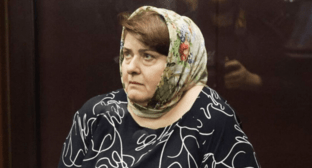21 August 2003, 05:32
Ossetian wedding ceremony
One of the most important and joyful Ossetian customs is the wedding ceremony. What is a traditional Ossetian wedding party?
MATCHMAKING. Any wedding party, in both the old days and our time, begins with matchmaking - sending in matchmakers. The matchmakers must be at least three in number. On of them, if possible, is the groom's uncle - his father's or mother's brother. Their foreman is usually the most respected neighbor; the third one can be a close friend of the bride's family, which usually makes things go faster.
The girl's family, as a rule, is informed of the guests' visit. The way they are received can tell about the outcome of the matchmaking. Yet, after the second toast, the foreman must tell the hosts about the goal of their visit. The head of the family thanks the guests for the honor and usually answers in approximately this way: "We have to consult the elders and relatives and, after all, ask the girl if she agrees, and only after that we can answer you." That is, in a covert manner he makes it clear that the outcome of the matchmaking can be favorable. At the same time they arrange for the next visit.
FIDYD (marriage agreement with the bride's parents). Nowadays, a fidyd can take place at both the groom's and bride's home, the latter occurring much more frequently. The young man's parents through their trusted people leave a money pledge at the girl's home as a sign that the two families have become related.
Sometimes the fidyd occurs on the wedding day, which is not either prohibited by traditions. At the girl's home, they arrange refreshments to entertain the fidaujit (trusted people). Better-off families kill a ram. While the meat is boiled, the quests are treated to refreshments and a couple of toasts are proposed. The table is then laid according to the custom. The foreman stands up and suggests discussing the matter they have gathered about. During the fidyd, they appoint the wedding day, discuss the number of guests to come for the bride, and who and when will bring the sacrificial bull-calf. This is followed by a meal.
On the table, according to the custom, there are three pies and the head and neck of the sacrificial animal. The foreman (toast-master) sits at the head of the table; to the right of him is the second foreman (the foreman from among the trusted people) and the third foreman (a family relative or representative) is to the left. Everyone stands up. The foreman (toast-master) proposes a toast to Styr Khuytsad (Big God); entrusts the young couple and the newly-related families to Mady Mairam (Virgin Mary), Uastyrji (St. George) and other saints; and passes over one of the pies and the bazyg (shoulder bone) to the youngest one at the table. The second and third foremen support the toast. The toast-master gives the floor to the oldest guest who proposes a toast to the health of the neighbors and villagers and wishes the two families to be content with the new relation and the happiness of the young couple to illuminate not only their families and friends, but also the entire Ossetia.
The foreman conducting the table makes sure no one is disregarded. When the meal reaches the climax, the third foreman cuts off the ear of the sacrificial animal, cuts it slightly three times and hands over to the foreman. The foreman blesses the youngest and hands the ear and a wineglass over to them.
In conclusion, the foreman asks Kasary Uastyrji (patron deity of the hearth) to place Ossetia, the newly-related families, and the young couple under his patronage.
Life introduces its own corrections to the age-old customs and traditions. Nowadays, after the agreement or more frequently on the wedding day, the young couple go to the vital records office to register their marriage. This ceremony is arranged with all possible pomp, so the couple will remember it for a long time.
SUSAGTSYD (Secret visit). The susagtsyd is performed a few weeks before the marriage. In a few days after the fidyd, the groom with the best man, groomsman, and a few friends pays a visit to the bride's place. If possible, this is not made public, only the next of kin and bridesmaids gather. The groom should necessarily have sweets to distribute among all the women in the house. Tables are laid for the guests and dances arranged.
The first toast at the table is proposed by the foreman (usually some one of the neighbors) to Great God, the second to Uastyrji. The third is to the happiness of the young couple.
The groom with his sworn brother - best man - and friends then goes to the khazar (traditional Ossetian room where the hearth was situated) to the elder women. The women give them nuazanta (honorary wineglasses); the bride's mother or mother-in-law, if there is one, offers the nuazan to the groom. The guests say thanks for the warm welcome and return the nuazanta putting money into them, as much as each of them thinks necessary. Some one of the younger women distributes the sweets brought by the groom. The women say thanks: "May your life be as sweet as these sweets." In the course of the susagtsyd, the groom presents the wedding ring to the bride.
The meal can last until late at night, but whatever the developments, the groom must not stay at the bride's home.
KUKHYLKHATSAG and AMDZUARJYN (Best man and helpmate). As a matter of fact, these are the key characters during the festivities, particularly the best man. Order at the wedding party depends on his management and organizational abilities; he decides whom and when to send for the bride, how to welcome guests, and so on. As a rule, the best man and his helpmate are appointed from among the family's friends, relatives, or the groom's friends.
The best man is in charge of order not only at the groom's, but also at the bride's home. When the wedding feast comes to a close and it comes time to lead out the bride, the best man with representatives of her family (this is usually the bride's brother or some one of her next of kin) enters her room.
The girl's relative asks God to bless his sister and give her love and happiness in the new family and that she will not dishonor the family. After that, he lets the women dress the bride. A couple of young female neighbors do this usually.
Before the wedding, the master of the house invites a few neighbors that are the closest to him and entrusts them his household. They, in turn, discuss who will be the uyrdyglaujyta (lit. "standing upright," i.e. people serving the guests during the feast) and who the kabitsykhitsau (lit. "the master of the pantry," the one to administer the food store during the wedding and feast).
WEDDING PARTY. The wedding procession with musicians stops at the bride's house. The elder folk come out to meet them. Someone of the young carries three pies and Ossetian beer. The foreman praises the Lord and wishes that from now on only such respected guests would visit this home and that the festivity they have gathered about would be pleasing to God and his angels.
After that, the guests are invited into the house. The young dance, after which the guests sit to table. The feast is conducted by the table foreman. On the table, according to the custom, there is the head and neck of an animal, usually a bull-calf (the neck is necessarily on the left), and three pies. The toast-master has the animal's shoulder. The oldest participant in the wedding procession has a shashlik (roast meat); he performs as the second foreman. The third foreman has a three-rib shashlik that usually stands for the bride's family or maternal relatives. The table foreman stands up with a bowl of beer in his right hand and the shoulder in his left hand. Everyone at the table stands up, they young come closer. The foreman says a prayer toast:
Farn, Farn, Farn!
Seven sons
and three blue-eyed little daughters!
Farn, Farn, Farn!
Like a broody hen - with many children!
Farn, Farn, Farn!
Like a she-bear - fertile!
Farn, Farn, Farn!
Like a hard-necked bull!
Farn, Farn, Farn!
Loved by the family!
Farn, Farn, Farn!
Respected by the neighbors!
When the veil is lifted, the bride begins to treat elderly women with the content of the Mady Kus (a bowl with a mixture of honey and melted butter). When the bride treats her mother-in-law to honey, women wish they would be the as sweet to each other as those honey and butter. After this ritual, the bride is again taken to her room where revels, dances, and songs are resumed.




